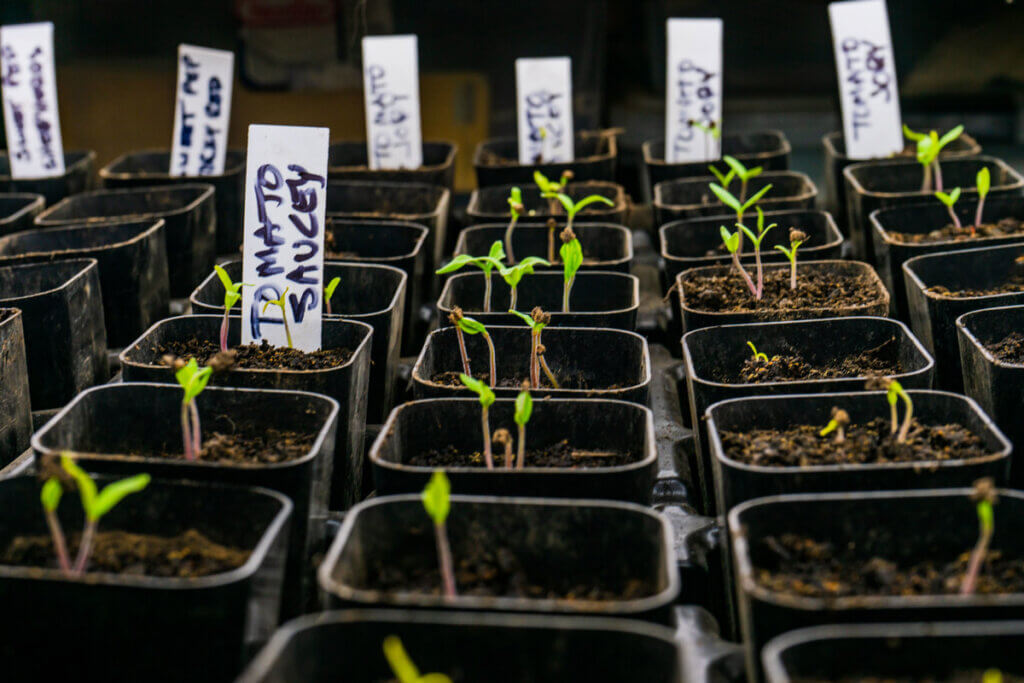We love a good home-grown tomato. We grew them successfully for years when living in Southern California and Tennessee; however, once we moved to the far north of Idaho, we struggled due to extreme temperature fluctuations and a short growing season. You may be wondering if it’s possible to grow tomatoes in cold climates. The answer is yes! In this post, we’ll uncover the seven helpful tips we’ve used for growing tomatoes in cold climates.

Table of Contents
ToggleWhy We Grow Tomatoes
Here in the far north of Idaho, we have to employ our best tricks to extend the growing season if we want to grow a year’s worth of food. Tomatoes are a crop that will not survive a frost, so two of our tricks are to start our seeds indoors and transplant our tomato seedlings once the last threat of frost is well past.
Though we thought building a hoop house would be the game changer for our tomatoes, it turns out it wasn’t (we’ll dive into the more in a bit). Though we still plant tomatoes inside our hoop-house (minus the greenhouse fabric), it’s so we can use our tomato string trellis method to keep them up off the ground.

By using these methods (plus the others we list below), we’ve been able to grow vine-ripened tomatoes in our cold climate, enough of them to preserve and enjoy them all year long. Here are our favorite ways to preserve tomatoes:
- Freeze-Dried Tomatoes (I may never can a tomato again!)
- Dehydrating Tomatoes (Three Easy Ways)
- Fermented Tomatoes Recipe
- Fermented Tomato Sauce

Our Tomato Growing Experiment
Though we’ll share some of the best methods for growing tomatoes in a cold climate in this post, this year, we decided to break some of these rules to see what would happen in our specific garden.
If you missed our early garden tour video, watch that to get familiar with some of our frustrations about growing tomatoes in our colder climate. Then, watch the video below for our update, what we experimented with and how it all worked out.
How to Grow Tomatoes in Cold Climates
Choose Cool-Climate Varieties
When attempting to grow tomatoes in cooler climates, it’s important to choose varieties that are adapted to those colder growing conditions. Furthermore, you also want to look for tomato varieties that ripen faster. This would be the “date to maturity” information on the seed packet.
Whether growing cherry tomatoes, slicers or paste tomatoes, the date to maturity is going to matter. We’ve found that some of the determinate varieties do better as they generally have a shorter date to maturation.


We tried multiple different varieties from Azure Standard this year and were very pleased with them. If you didn’t already know, Azure Standard offers Ellie’s Eden garden plant starts in early spring. If you’re not set up to start tomatoes indoors, buying tomato plants from Azure is a fantastic option.
For first-time Azure Standard customers, you can get 15% off your order of $100 or more delivered to a drop location! Just use the link above and coupon code “HOMESTEADINGFAMILY15” at checkout.
Generally speaking, dwarf or determinate varieties are better for getting a harvest in a colder, shorter climate. Here are some great tomato varieties for cool climates:
- “Juliet”
- Early Cherry
- Ailsa Craig
- Beaverlodge
- Glacier
- Latah
- Moneymaker
- Red Alert
- Shirley F1
- Siberian
- Stupice
- Sub-Arctic Plenty

Start Seeds Indoors
You’ll want to start your tomato seeds indoors to get a jump on the growing season. Where we live, if we direct-sow our tomatoes, we likely wouldn’t get any ripe tomatoes until just before our first frost in the fall.
It can be tempting to start tomatoes much earlier than you need them, but we’ve found starting them too soon causes other issues. Start tomatoes six to eight weeks before your last frost date in the spring.

Transplant After Last-Frost
When transplanting tomatoes into the garden, there are a few tomato planting tips you’ll want to follow. You can read that blog post for more information, but you’ll also want to consider the planting location. Look at your garden, is there a sunnier spot that tends to get more sun throughout the day? Perhaps you have a southern-facing wall with some growing space below it.
Though we haven’t tried this, some people recommend using grow bags and growing tomatoes on a sunny driveway where you’ll get more heat from the sun.
The big key here is to transplant tomatoes out once the threat of frost is well past. Even better, wait until your lows are 50°F or higher.
When planting tomatoes, consider adding some active compost to the soil. Compost has a tendency to be a bit warmer with all the microbial activity happening. If you want to learn more about making your own compost, check out our compost archives here.

Protect Tomatoes From Extremes
Our issue with growing tomatoes in a cold climate is not the cooler temperatures during the day but during the evening. We can be in the 90s during the day, dipping down to the 40s in the evenings. This large temperature fluctuation causes stunting and prevents blossom/fruit formation.
For many years, we tried growing our tomatoes in our DIY hoop house (pictured above), thinking that would insulate them in the evening. This works great for young tomatoes as they’re just getting started. However, unheated greenhouses typically only gain about 3-5 degrees from the cold temps.
Furthermore, even with proper ventilation (lifting up the greenhouse plastic during the day), we found that there wasn’t enough airflow for our tomatoes.
Now our recommendation is to protect young tomato plants with insulated plant covers. Even an empty milk jug turned upside down over the plant can help protect your plants from cooler temperatures while it’s young.
If you have something like a high tunnel that allows for heat retention at night but also enough airflow during the day, this is ideal.

Hand Pollinate
If you feel like your tomatoes are taking forever to form (after seeing blossoms), consider hand-pollinating. This seems way more tedious than it actually is.
You can hand-pollinate by shaking the tomato plant slightly. Sure, the wind and insects will pollinate for you (eventually), but shaking the plant every few days just speeds the process along.

Water Temperature
Something else to consider, if you have the means to change it, is the temperature of the water when watering your tomato plants. If you water plants at night, like we do, they’re already dealing with the drop in temperature from the chilly evenings, so adding cold water on top of that can cause the plant’s growth to be stunted.
If you have the ability to catch rainwater and store it, this tepid water would be much better to water your tomatoes with.
That being said, we also realize there’s only so much a gardener can do in a day, so take this with a grain of salt. If it’s an easy fix, then heed this advice. Otherwise, by following the tip for growing tomatoes above, you’ll likely find success.
You can learn more about our garden watering strategies here.

Prune Your Plant
Pruning your plant is one of the best ways to speed up fruit production and stop the plant’s energy from going into new leaf and sucker production. However, if you’re like us, you also want to grow tomatoes that don’t need quite so much fussing over.
There’s a happy medium to be found here. We like to find the right variety that does well with or without pruning, then spend a minuscule amount of time tending to the tomato vines as they grow with some trellising.
We do like to prune off any flowers toward the end of the growing season to push all the energy into fruit ripening as possible. For the fruit that’s still green at the time of our first frost, we’ll pick them all and ripen the green tomatoes indoors.
With these tips, I’m confident that you, too, will be able to grow vine-ripened tomatoes for your family each year. Though it may take some experimenting for your specific climate, don’t give up hope!



















